How to defend corner kicks is an essential skill the team must possess in order to win more games. In a game of soccer, it will always be incredibly frustrating to concede a goal from a corner. This can sometimes go against the run of play as the attacking team can score from virtually nothing. Corners give the attacking team a great opportunity to score as it gives them the chance to deliver the ball into a dangerous area for their attackers.
Typically defending teams will concede goals from corner kicks either from a perfectly executed attacking corner or through a lack of organization and communication.
A study that looked into 1139 corners kicks taken from 124 matches in the FIFA World Cup (64 matches), UEFA Euro 2012 (31 matches) and the UEFA Champions 2010-2011 (29 matches) found that only 2.2% of corner kicks ended in a goal but that goal was responsible for a team winning or drawing the match on 76% of the occasions.
Reference: Analysis of Corner Kick Success in Elite Football
These are the fine margins that can ultimately be the difference between winning and losing, which is why coaching your team on how to defend corner kicks is imperative.
This post will help you have a better understanding of how to set your team up to defend corners and it will also go over individual coaching points you can teach your players to defend corners.
This will help increase your success rate of defending corners.
How to set up to defend against corner kicks
When coaching your team how to defend from corner kicks it is important to understand what areas attacking corner kicks are being delivered to and from what sides.
From here you will be able to decide how to set up your defense at corners as you will know what areas teams are most likely to cross the ball from corners
Below shows data collected from 606 corner kicks across 64 matches in the 2018 FIFA World cup, with the first diagram showing the area and the frequency of where corners were delivered from the right-hand side and the second one from the left.
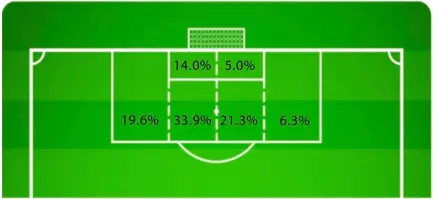
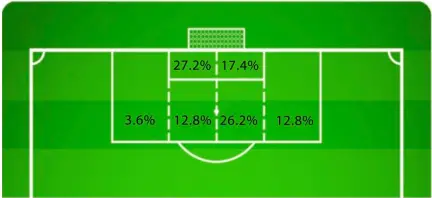
Reference: Analysis of corner kicks in FIFA 2018 World Cup
From the two diagrams, it is clear that the chances of the ball being delivered from the left or right will be heading toward the central area of the penalty box are incredibly high.
This is the area where a team must focus on winning the first ball to ensure the corner is successfully defended.
There are 2 defending corner tactics you can use to maximize your teams’ success defending corners.
You can either defend corners using zonal marking or defend corners using man-marking, but which is better?
Defending corners using zonal marking
What is zonal marking in soccer?
Zonal marking is a defensive tactic used in soccer. Instead of asking players to mark a player, players are asked to mark a specific area.
For example, using the diagram above you know that a large percentage of crosses are delivered into the center of the box so you would want to ensure that you have defenders strategically placed to mark these zones.
What are the benefits of zonal marking?
Zonal marking allows a team to evenly spread their players to try and increase their chance of winning the ball. Players will know what zone of theirs to defend and so it can prevent 2 defenders on the same team from going for the same clearing header.
By using zonal marking when defending corners, the attacking team will find it a lot harder to create space for themselves this is because the defenders are marking the space instead of marking the players.
Making the defensive setup a lot more robust.
What are the negatives of using zonal marking?
One of the main negatives of zonal marking is that defenders will stand still when jumping to win the ball. Attackers who are running onto the ball while attacking will be able to jump higher and adjust more easily to where the ball is going.
This will put defenders at a serve disadvantage.
Defenders are maybe hesitant as to who should win the ball if it lands in-between zones.
This means defenders may not challenge the corner kick coming in as they would both be expecting the other player to get it.
This will give the attacker an easy attempt on the goal unchallenged.
Defending corners using man-marking
What is man marking in soccer?
Man marking in soccer is where you give the responsibility of one of your players to track and watch a run of the player on the opposing team, in an attempt to win the ball ahead of the attacking player.
So instead of marking a specific area like zonal marking, you now have to mark a specific individual.
When considering using this tactic you must try to match up your players against the attackers taking into account their physical attributes.
You wouldn’t want to place a 5’5 winger against a 6’4 central defender!
What are the benefits of man-marking in soccer?
Man marking in soccer to defend corners is a great way to track the runs and win the ball ahead of the attackers. This is because players will be running onto the ball with speed and momentum allowing them to jump higher and adjust quickly to where the ball is going.
There should be no hesitation when challenging the ball as everyone has the responsibility of trying to win the ball against their opposing attacker.
It is a lot easier to negate the attacking threat if players stay with the attacker they are supposed to be marking.
What are the negatives of man-marking?
One of the great strengths of man-marking can be used against the defending team through clever attacking corner tactics.
As players have to follow the attacker they are marking, attackers can drag defenders out of position which can create space for other attackers to move into to attack the cross.
Another negative of man-marking attackers is that defenders may only watch the ball and lose track of the player they are marking or vice versa.
This is the best way to set up to defend against corner kicks
The best setup to have when defending corners is a mix of both the zonal marking and man-marking tactics.
A study that looked at 600 corners across 64 games in the 2018 FIFA world cup found that teams conceded more goals using a zonal marking strategy (6.0%) compared to a mixed marking strategy (3.7%).
They suggest having a player on the front and back post too as a part of a successful defensive setup.
Reference: Analysis of teams’ corner kicks defensive strategies at the FIFA World Cup 2018
Another effective zonal marking strategy is to place players in the space that is in front of the near post as shown in the diagram below.
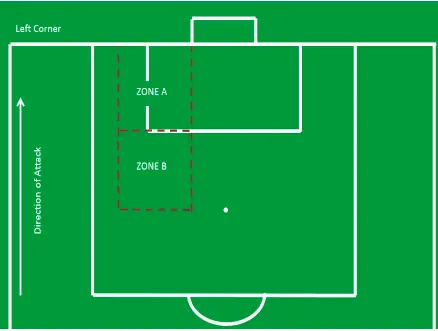
A study that looked at teams that placed players in these zones found that the players won a combined total of 31.5% of total corners that were delivered. This data was taken from 750 corners taken from 79 matches in the 2015/16 Premier League season.
The most effective combination of players in these zones would be to have 2 players in zone A and 1 player in zone B.
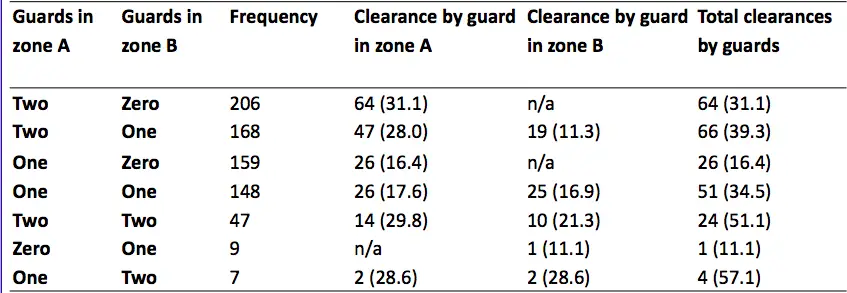
Reference: DEFENDING CORNER KICKS IN THE ENGLISH PREMIER LEAGUE: NEAR POST GUARD SET-UPS
This is how you could set up your team to defend corners
If you set up you could use a combination of zonal marking and man-marking with a player on the inside of each goalpost.
You could place 2 players in zone A and 1 player in zone B to protect the space in front of the near post.
Try to leave one of your attackers on the halfway line and a player roughly halfway in your own half. This will force your opponents to leave at least 3 players back (typically teams would always want to have a player advantage from this position to prevent a counter-attack).
If you clear the ball from the corner you will have an outlet in these players to potentially start an attack.
This would leave the rest of your players to man-mark.
You should ensure that your players are physically matched against the players they are marking.
Player coaching points and other useful tactics on how to defend Corner Kicks
Now that you know how to set your team up and where to position your players, here are some other tips and coaching points you need to make sure your team understands to be as effective as possible when defending corner kicks
What your body position should be like defending corners
Regardless of how good your setup is, if you players do not know how to defend 1v1 on corners then your team will continue to concede.
Players must be able to position themselves in such a way that they can see where the ball is coming from as well as be able to see the player they are marking.
The defender should also position themselves in a ‘goal side’ position.
This means that defender places themselves in between the attacker and the goal, which will prevent the attacker from having a run into the open space unmarked.
While marking your player, always make sure they are an arm’s length away. If you are too far away this will give the attacker too much time and space, however, if you are too close the attacker can lose you with some quick movements.
How to defend a corner kick as a goalkeeper
As a goalkeeper, you would want to position yourself in the center of the goal angled towards the side at which the corner is being delivered.
The best to position yourself as a goalkeeper would be in the middle of the goal.
You would then want to put your body in a position that is at an angle towards the side that the corner is coming in from.
This means that you can see everything that is happening in front of you and the corner kick as it gets taken.
It is important that you are on your toes and ready to react.
Make sure you are confident in your decision if you are coming out to collect the ball, as you jump make sure you raise the knee to protect yourself while in the air and call for the ball loudly to put the attackers off and let your defenders know not to challenge for it.
The goalkeeper can play a huge role in the organization of the defending team. This is because they are the only player than see everything in front of them.
Players must move up the field when the ball is cleared
The offside rule will come back into play when the corner kick is taken.
As soon as the ball moves back either through clearance or the attacker passing it backward, the defensive line steps up.
This means attackers may be caught offside if the ball is played back into the box.
Players can then be caught offside if they did not move up with the defensive line
Sitting deep and not getting out quick enough will invite more attacking pressure from the opposing team
It also gives an opportunity for the defending team to relieve pressure and put pressure on the opposing team.
All the players on the defending team have to make sure they are on the same page because if one player does not step up then this tactic does not work.
Make sure players know their roles and tactics
Defending corners effectively will only work unless players have a full understanding of their roles in the system.
All it takes is one or two players to know what they are doing and to make a mistake for a chink in the armor to appear.
Discuss all the tactics and individual roles with players beforehand and make sure you have worked on them consistently in soccer practice.
Conclusion on how to defend corner kicks
Being able to defend corner kicks successfully can be the difference between a good team and a great team. These are my best tips on how you concede fewer goals from corners.
Here are the key takeaways on how to defend corner kicks:
- The most effective way to defend corners is to use a combination of man-marking and zonal marking
- Place players on the post and players defending the front post space (zonal marking). These players cleared the ball the most
- Make sure players understand the tactics and their roles within the system
- Teach your goalkeeper to be loud, confident, and position themselves so they can make the best possible decision
- Coach your players on how to effectively defend 1v1
- Practice!
Let me know if you have used any other tactics to help your team defend against corners then leave a comment below.
If you know a coach who would find these defending corner tactics useful then share them using the social media buttons.
Thank you!
Toby
Related Posts:
My Soccer Coaching Equipment
If you opened my coaching bag this is the soccer equipment you’d find!

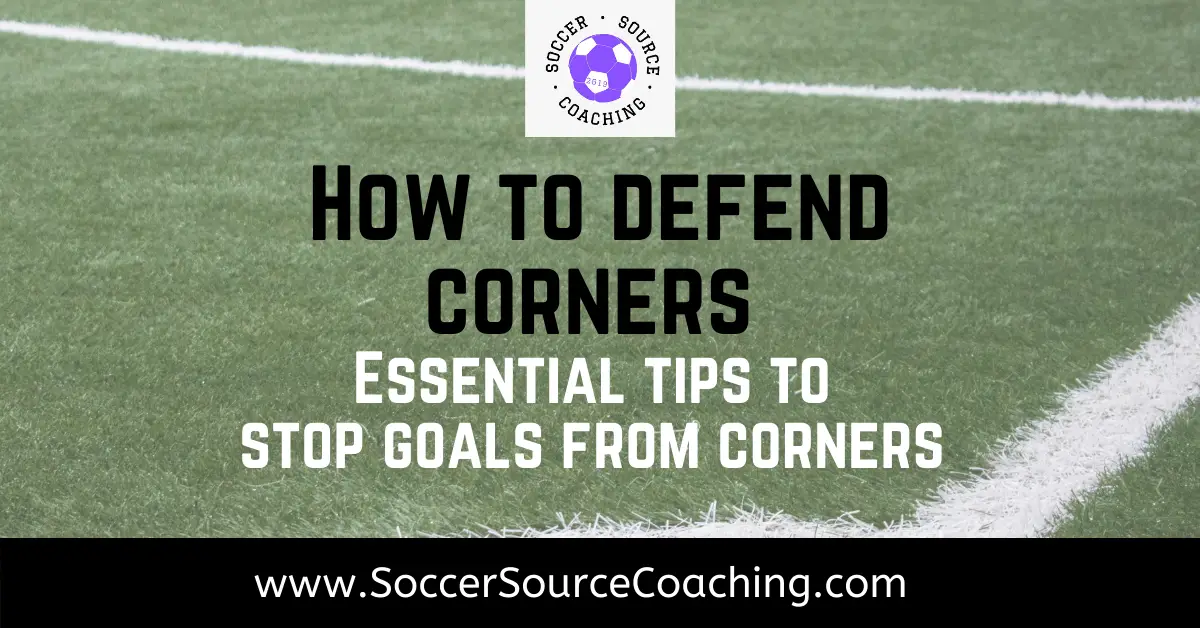
2 thoughts on “How To Defend Corner Kicks | Stop Goals From Corners”
Comments are closed.